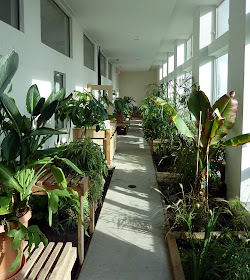In early November 2013 I returned yet again to Fairfield, Iowa, for a meditation intensive (the Invincible America Assembly, or IAA), for 7 days of Ayurvedic treatments at The Raj, and to see friends and poke around. Not that there was an abundance of free time between the IAA and The Raj. If you've been following this blog, you may wonder what I'll have to write about this time that hasn't already been said. So do I! But don't worry, instead of Fairfield for Spring 2014 I will go someplace I have never been before.
My first photo will be my favorite one from this trip. It's first so that it will be the displayed photo under 'Recent Posts' or 'Popular Posts.' A cyclist rides away from the Men's Dome, after evening program, in front of the Maharishi Tower of Invincibility. I saw this alignment one night, and kept an eye and my camera out for any re-occurrence. I captured this image a couple of days later.
I roomed in a different place this time. I was north of the campus, in North Campus Village, instead of south. The building I was in contained several condos.
A short cut-through connects the North Campus Village with the Fairfield Loop Trail in several locations.
The new location changed my commute to and from the Golden Dome, which made it possible for me to notice the cyclist in front of the tower. When I arrived the trees in front of the Dome had changed color, but the leaves were still attached. This didn't last long.
The long driveway down to the Raj was brilliantly colored as well.
Here's a closeup.
For details about the Raj, I'll refer you to this post and this one. The staff was wonderful, as usual, and the treatments gave me a good "reset" of my physiology.
The store nearby to campus, Everybody's Whole Foods, was setting up a two-level railroad display for the holiday season.
The Sustainable Living Center on the MUM campus was now fully open for activities. Bob Argo, who came out to Fairfield with me, and our mutual friend in Fairfield, Cary Davis, and I took a walkthrough. Here is one of the classrooms.
The building is supported by intact tree trunks; these are stronger than sliced-up boards.
The circular glass you see above the doorway in the above photo, slightly higher than dead center, is a stained glass rosette.
One of the informative panels on the main hallway lists the certifications this building has earned -- not just one. Click to enlarge.
The south face is used for many different plantings.
Elsewhere on campus, the venerable bridge over a vanished stream has been closed off. It's falling apart. I suppose there's no point in maintaining a bridge over nothing, but I still find it melancholy to see it wither.
On one walk downtown Bob, Cary, and I had a brief but fascinating visit at the ICON (Iowa Contemporary Art) Gallery and Bill Teeple Studio, which share the same space.
One of Bill's special talents is the drawing of small nature scenes in pencil. I do mean small:
With extreme cropping, I can present an image that will give you can idea of what he does, although all the exquisite detail is lost in this photo.
Although Bill was busy switching exhibits in the ICON Gallery, he took several minutes to show us how he uses a pencil to create entrancing scenes.
Thank you, Bill!
The other big excursion was to the site where Steve Nolle was having a Sthapatya Ved house built. Steve is on the Computer Science Faculty at MUM; I met him at least a decade ago when we were both attending various week-long retreats at MUM. Back in the day, we discovered, we both worked for Bell Labs. I was in Columbus and he was in the Chicago area.
We approached the house, which is in a "four-square" style, where each side is the same length.
The sides have plenty of windows for admitting light. Here's a closeup of the south face.
The entrance faces east, in accordance with Sthapatya Vedic principles.
The builder is known for his post-and-beam construction, but Steve convinced him to try an experiment and use a robust but typical American balloon frame. The builder did include posts in the porch design, above.
The full basement was built with insulated, poured concrete forms.
It's easy to run a conduit to the electrical outlets -- just dig a small trench in the insulating form, as you can see above (click to enlarge).
Here Steve is explaining the passive radon-venting system built into the foundation.
The roof and ceiling beams are huge. This photo doesn't do them justice.
Steve pointed out the various rooms in the interior.
This is the view through the south windows.
This is the view to the north. Beyond the fence is cattle pasture, retained by the original owner of the land.
It was intriguing to see this style of house under construction. It's more solidly built than the average American home, and has many ecologically-minded features.
For my final photo from this trip, a sunset view from North Campus Village.
The next trip will be in an entirely different direction.





























No comments:
Post a Comment
Comments may not appear immediately as they are moderated by the author to eliminate spam. Please, no commercial links!